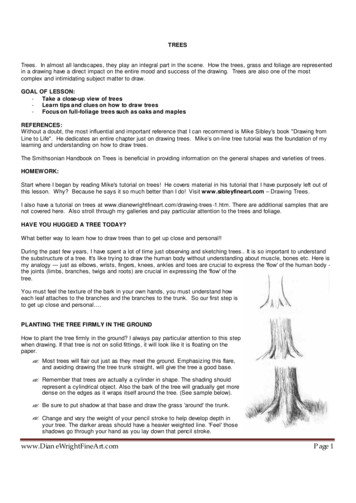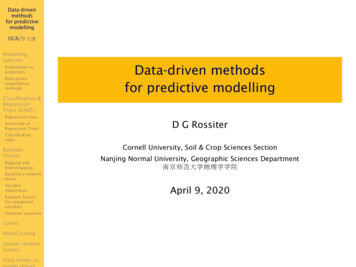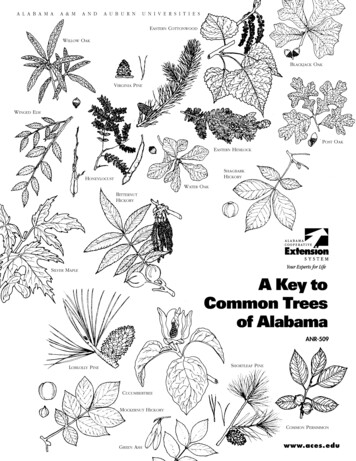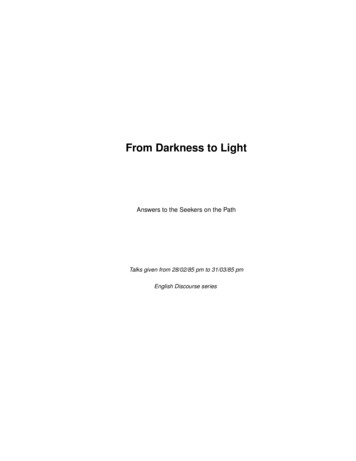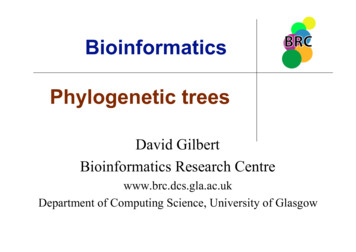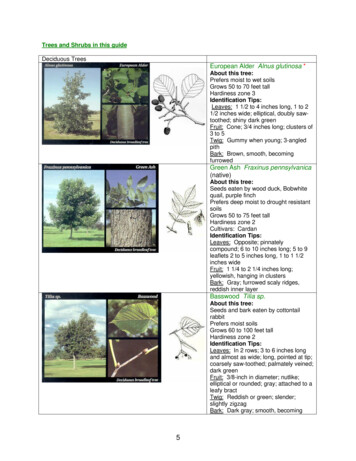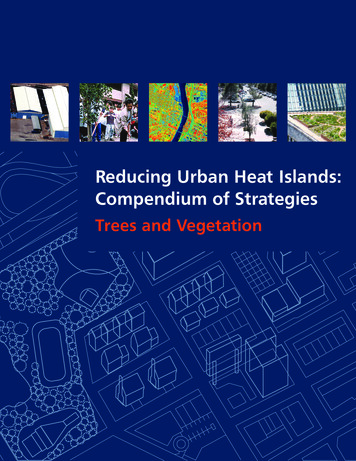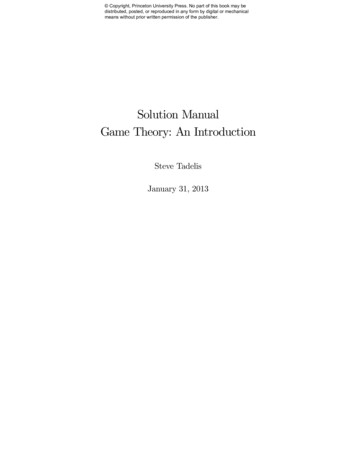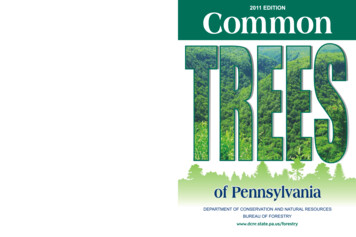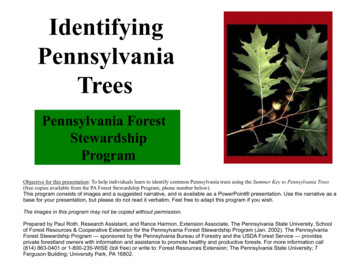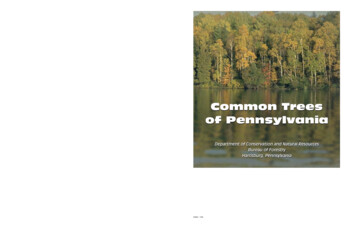
Transcription
Compliments ofYour State SenatorCommon Treesof PennsylvaniaDepartment of Conservation and Natural ResourcesBureau of ForestryHarrisburg, Pennsylvania#5005 - 7/06
IntroductionForests have always been important to the inhabitants of the area we now call "Pennsylvania" (Latin for "Penn's Woods").Pennsylvania's location spanning 40 degrees - 42 degrees north latitude and its varied terrain support 108 species ofnative trees and many other introduced from Europe and Asia. Trees provide a renewable source of lumber, paper, nutsand chemicals. But they are also essential as living filters, removing pollution from the air we breath and the water wedrink. Trees provide homes and food for wildlife, and beautify our homes with comforting shade in summer and shelterfrom winter winds. With wise management, forests can produce these benefits for future generations as they have in thepast.The first human beings to hunt and gather plant foods in these forests left stone tools and spearpoints at scatteredcampsites about 10,000 years ago. Clearing of areas for farming and villages began almost 3,000 years ago. AfterEuropeans settlements were established along the Delaware River 400 years ago, the pace of clearing land foragriculture and the use of forest products for housing, food, fuel and the manufacture of tools, furniture and other goods,increased dramatically and expanded westward across the state. By the early 1900's, all but a few small isolated areas ofvirgin forest had been cut,leaving landscape of stumps and scrub growth over much of the Commonwealth. Wildfires werea common occurrence in this brushland and would rage uncontrolled for days, over thousands of acres. Today's forestshave grown out of the seemingly barren conditions left after mass cutting and severe fires. Pennsylvania is now nearly60% forested, having 18 million acres of woodlands. And today, we still derive much of our economy and many comfortsfrom the flora and fauna of Penn's Woods. Medicines, foods, and wood fiber, a cleaner environment, tourism, andrecreation are all provided by our forests.This selection of 57 native, and 5 introduced trees is organized according to leaf shape and arrangement. Each tree isidentified by popular name familiar to Pennsylvanians and its complete scientific name. To use this book, first study thedrawings on the parts pages, and the glossary until you understand “needle-like”, “simple” and “compound” leaf shapesand “alternate” and “opposite” leaf arrangements. Then compare the tree you wish to identify with the following table andstudy the pictures on the appropriate pages.#1. Leaves needle-shaped or linear .trees 1-111. Leaves wide and flat2. Leaves in opposite arrangement3. Leaf shape simple.trees #12-183. Leaf shape compound .trees #19-222. Leaves in alternate arrangement4. Leaf shape simple. trees # 23-524. Leaf shape compound .trees #53-62tOther sources of information can be found in your local library or bookstore. Popular and scientific names used in thisdocument are from The Vascular Flora of Pennsylvania: Annotated Checklist and Atlas by Ann Fowler Rhoads andWilliam McKinley Klien, Jr., American Philosophical Society, 1993.ii
GlossaryAxil - The upper angle where a leaf stalks joins the stem or a smaller stem joins a larger one.Alternate - One leaf attached at each node. See opposite and whorled.Capsule - A dry fruit which contains more than one seed and splits open when ripe.Catkin - A compound bloom consisting of scaly bracts and flowers usually of one sex.Deciduous - Refers to trees which drop their leaves in autumn. Compare to evergreen.Downy - With very short and weak soft hairs.Drupe - A type of fruit having a single seed enclosed in a hard layer and that is covered with soft,often juicy flesh, as in cherries and peaches.Evergreen - A plant that retains green leaves throughout the year. Life span of an individual leaf canbe 2-15 years.Leaflet - A leaf-like portions of the blade of a compound leaf. There is no bud in the axil of its petiole.Leaf Scar - The impression in a twig at the point where a leaf was attached.Lenticel - A pore in the bark of young trunks and branches through which air passes to interior cells.Lobe - A division or projecting part of the blade of a leaf.Opposite - Two leaves attached at each node. See alternate and whorled.Pedicel - The stalk of a flower or inflorescence.Petiole - The stalk attaching a leaf blade to the stem.Pith - The spongy material in the center of twigs and young trunks.Sessile - Refers to a plant part having its base attached directly to the stem without an interveningstalk.Stalked - Refers to a leaf or flower having a length of petiole or pedicel between its base and thestem. See sessile.Witches'-broom - Abnormal brushy growth of small branches caused by an infection.Whorled - Three of more leaves or other parts attached to a stem at the same point.iii
Parts, Types, and Postions of Leavesiv
Parts, Types, And Positions of Leaves, Page 2v
Parts, Types, And Positions of Leaves Page 3vi
1Eastern Hemlock(Tsuga canadensis (L.) Carr.)LEAVES: Evergreen needles occur singly, appearing 2-ranked on twigs, flattened, about1/2" long, dark green and glossy, light green with 2 white lines below.TWIGS: Slender, tough, yellowish brown to grayish brown. Buds eggshaped, 1/16"long, reddish brown.FRUIT: Cones 3/4" long, egg-shaped, hanging singly from the tips of twigs. Under eachscale are 2 small, winged seeds.BARK: Flaky on young trees, gray brown to red brown, thick and roughly groovedwhen older.GENERAL: A large, long-lived tree, important for construction timber and as a sourceof tannic acid for tanning leather. Found in cool, moist woods throughout theCommonwealth, Eastern hemlock is the offical state tree of Pennsylvania. Ruffledgrouse, wild turkey and songbirds find food (seeds) and shelter in this tree. Deer browseit heavily when deep snow makes other food scarce.1
2Eastern Redcedar(Juniperus virginiana L.)LEAVES: Evergreen, opposite, two types (often on the same tree) the older morecommon kinds are scale-like and only 1/16"-3/32" long, while the young sharp-pointedones may be up to 3/4" in length; whitish lines on the upper surface.TWIGS: Slender, usualy 4-sided, becoming reddish brown. Buds small and not readilynoticable.FRUIT: Bluish berry-like, covered with a whitish powder, about 1/4" in diameter; fleshsweet and resinous; contains 1-2 seeds. Ripens the first year.BARK: Reddish brown, peeling off in stringy and flaky strips.GENERAL: A slow growing and long-lived tree, to 40' high. Red cedar is adaptable toa variety of wet or dry conditions. It is common in abandoned farm fields in the southerntier counties and on rocky bluffs. The wood is used chiefly for fence posts and mothproof chests. Cedar wax-wings and other song birds and game birds eat the fruits.2
3Colorado Blue Spruce(Picea pungens Engelm.)Leaves: Needles 4-sided, stiff, in-curved and spiny pointed to 1/4", usually blush-green,persist for 7-10 years.Twigs: Orange-brown turning gray-brown with age, without hairs. Buds dark orangebrown.Fruit: Cones to 4" long, cylindrical, tapering slightly at the tips, shiny chestnut brown;scales with irregularly toothed margins.Bark: Relatively thin, scaly and pale gray when young becoming furrowed and reddishbrown with age.General: A widely planted ornamental in Pennsylvania, Blue spruce is native to theRocky Mountains at elevations of 5,900'-10,000'. Slow growing and long lived,specimens can reach 150' high. Cultivated varieties can have silvery-white or goldenyellow needles.3
4Norway Spruce(Picea abies (L.) Karst)LEAVES: Evergreen needles occur singly, spirally arranged on twigs, sharp-pointed,four-sided, usually 3/4" long, dark green.TWIGS: Bright, golden-brown. Buds egg-shaped, darker than twigs.FRUIT: A cylindrical cone, 4"-7" long, light brown; scales with finely toothed margin,broader than long.BARK: Relatively thin, reddish brown, scaly, becoming gray-brown but seldomfurrowed on old trees.GENERAL: A European species that has become a valuable naturalized member ofour forests, and extensively planted as an ornamental. A large tree with a dense conicalcrown. Branchlets on older trees droop. Wood used chiefly for paper pulp, boxes, cratesand lumber.4
5Red Pine(Pinus resinosa Ait.)Leaves: Evergreen needles in clusters of 2, slender, 4"-6" long, dark green, borne indense tufts at the ends of the branchlets: snap easily when bent double.Twigs: Stout, ridged, yellow-brown to red-brown, buds egg-shaped, about 1/2" long,brown at first and later silvery.Fruit: A cone, about 2" long, without prickles, nearly stalkless, remains attached until thefollowing year.Bark: Comparatively smooth, reddish brown.General: Like white pine, this medium to large-size tree developes one horizontal whorlof side branches each year. A valuable timber tree in the northern part of the state, itswood is used chiefly for construction lumber. Native on dry slopes in Luzerne, Wyoming,Tioga, and Centre counties and planted extensively by the Bureau of Forestry and thePennsylvania Game Commission. Songbirds, mice and chipmunks feed on the seeds.5
6Scots Pine(Pinus sylvestris L.)LEAVES: Needles 2 per cluster, 1½" - 3½" long, bluish-green or dark green stout,twisted, circular in cross-section.TWIGS: Fairly stout, brittle, dark yellowish-gray, smooth.FRUIT: Cones 1½" - 2½" long, short-stalked, solitary or in pairs, usually pointingbackward, grayish or reddish color.BARK: Scaly, peeling off in flakes from ridges separated by long shallow fissures.Lower trunk rough and grayish, upper trunk rather smooth and distinctly reddish.GENERAL: Native to Europe, tolerant of various soil and moisture conditions butintolerant of shade. Typically reaching 70' in height it can attain 120' with a diameter of3'-5'. Widely planted for reforestation and horticulture, with occasional escapes fromcultivation. Older books sometimes call it Scotch pine.6
7Table Mountain Pine(Pinus pungens Lamb.)LEAVES: Needles in clusters of 2, 2"-4" long, light bluish-green, stout and very stiff,twisted and sharp-pointed, tufted at the ends of branches, persisting 2-3 years.TWIGS: Stout, rather brittle, at first smooth and light orange to purplish, later ratherrough and dark brown.FRUIT: Cones 3"-4" long, sessile, in whorls of 2-7, oblique at the base, light brown,egg-shaped. Cone scales much thickened and tipped with a strong, curved spine.BARK: Dark reddish-brown, roughened by shallow fissures into irregular plates whichpeel off in thin films.GENERAL: Attains a height of 30'-40' on dry, rocky and gravelly slopes and ridge topsin the southcentral and southeastern counties. Not usually used for lumber due to its smallsize, it can display aggressive growth suited to protecting rocky slopes from erosion.7
8Virginia Pine(Pinus virginiana Mill.)LEAVES: Evergreen needles in clusters of 2, twisted, stout, relatively short 1½"-3"long.TWIGS: Slender, curved, flexible, brown to purple with bluish white coating. Buds eggshaped, usually less than ½" long, brown and resinous.FRUIT: Cone 2"-3" long, prickles small but sharp, edge of scales with darker bands,usually without a stalk, remains attached for 3 or 4 years.BARK: Smooth, thin, reddish brown and scaly, shallowly fissured into small flat plates.GENERAL: Also called Scrub pine, this small tree attains a height of 30'-40' on sandyor poor rocky soils of barrens and ridgetops. Virginia pine is a southern species thatreaches its northern limit in Pennsylvania. It is valuable as cover for worn-out farmlandsand is harvested for pulpwood. The seeds are eaten by squirrels, songbirds and gamebirds.8
9Pitch Pine(Pinus rigida Mill.)LEAVES: Evergreen needles in clusters of 3, stiff, 2½"-5" long, yellowish green.TWIGS: Stout, brittle, rough, angled in cross-section, golden-brown. Buds egg-shaped,about ½" long, resinous, red-brown.FRUIT: Cones 1½"-3½" long with short, stiff prickles, nearly stalkless, often remainsattached for 5 years or more after ripening. Many remain unopened until being heatedby passing forest fire.BARK: Green and smooth on young branches, thick, rough, grayish brown on oldertrunks.GENERAL: Pitch pine is a medium sized tree, 40'-50' high. Widespread inPennsylvania except the Northwestern counties it is more common on poor, sandy soilsand areas where forest fires have killed most other trees. Its wood has a high resincontent, and is used for railroad ties, construction lumber, pulpwood and fuel. Pitch pineseeds are important to nuthatches, Pine grosbeak and Black-capped chickadee. Deerand rabbits browse the seedlings.9
10Eastern White Pine(Pinus strobus L.)LEAVES: Evergreen needles in clusters of 5, soft flexible, 3-sided, 2½"-5" long, andbluish green. This is the only pine native to Pennsylvania with 5 needles per cluster.TWIGS: Slender, flexible, with rusty hairs when young, later smooth. Buds eggshaped, usually less than ½" long, gray-brown.FRUIT: Cones 5"-8" long, without prickles, slightly curved, resinous; each scale usuallybears 2 winged seeds as do all our native pines.BARK: Young trunks and branches greenish brown, later darker grooved and scaly.GENERAL: Eastern white pines are large trees. At present they usually reach 50'-90'high but the original "Penn's Woods" saw white pines reaching 150' and more. It is oneof the most valuable timber trees, found in moist or dry woodlands throughout the stateand often planted as an ornamental in large open areas. Many birds, squirrels,chipmunks and mice feed on the seeds and soft needles. Inner bark of white pine is apreferred winter food of porcupine and deer browse the twigs.10
11American Larch(Larix larcina (Duroi) K.Koch)LEAVES: Needles not evergreen; occur singly near the ends of the twigs, elsewhere inclusters of 10 or more; about 1" long, pale green, turning yellow and falling from the treeduring the autumn.TWIGS: At first covered with a bluish white coating, becoming dull brown and withnumerous short spurs. Buds round, small, 1/16" long, dark red.FRUIT: A cone, about 3/4" long, egg-shaped, upright, often remains attached forseveral years after ripening in the fall.BARK: Smooth at first, later becoming scaly, dark brown.GENERAL: A medium-sized tree also known as Eastern larch and Tamarack. Onlycone-bearing tree native to Pennsylvania that loses its needles annually. Found locallyin moist situations. Wood used chiefly for paper pulp, lumber, posts and railroad ties.European larch (L. decidua) and Japanese larch (L. leptolepis) are more commonlyplanted in the state.11
12Flowering Dogwood(Cornus florida L.)LEAVES: Opposite, simple, 3"-5" long; clustered toward tips of twigs; margins smoothor wavy; veins prominent and curved like a bow. Foliage bright red in autumn.TWIGS: Red tinged with green, often with a bluish white powdery coating; marked withrings; tips curve upward. End leaf bud covered by 2 reddish scales; side leaf buds verysmall; flower buds conspicuous, silvery, button-shaped, at ends of twigs.FRUIT: An egg-shaped drupe, 1/2"-3/5" long; coat red; flesh yellowish; stone grooved,2-celled; usually in clusters of 2-5; persist after the leaves fall. Flowers greenish white oryellowish, small, in flat-topped clusters; four showy white bracts underneath; openbefore the leaves.GENERAL: Bark red-brown to reddish gray, broken by fissures into small blocks, likealligator hide. A small native tree with low spreading crown, especially valued forornamental planting. Wood used primarily for textile weaving shuttles. Horticulturalvarieties with red or pink bracts have been developed.12
13Catalpa(Catalpa bignonioides Walt.)LEAVES: Opposite or whorled, simple, heart-shaped, 6"-10" long and 6" wide; marginentire or wavy; smooth above, hairy beneath.TWIGS: Stout, yellow-brown; no buds at the ends. Side buds small, appear to behidden in bark. Large, nearly round, depressed leaf scars are characteristic.FRUIT: Bean-like, to 15" long, ½" wide, halves separating when ripe, may persist ontips of branches all winter, many seeds, each with long white hairs on both ends.Flowers in July, arranged in terminal clusters about 10" long; each showy flower whitewith yellow and purple spots, 2" in diameter.BARK: Light brown, shallowly ridged and scaly.GENERAL: A short-trunked, broad-crowned tree, to 49', native to southern states, butnow widely planted and frequently escaped in the eastern U.S. Usually planted for itsshade and flowers, the wood is durable and useful for posts. The Northern catalpa, C.speciosa Warder, with larger flowers and wider pods, has also been planted in theCommonwealth.13
14Norway Maple(Acer platanoides L.)LEAVES: Opposite, simple, coarsely 5-lobed, 4"-7" wide, milky sap exudes from thebroken leaf-stalk.TWIGS: Stout, reddish-brown. Buds glossy red with green at the base, bud scales withkeel-like ridges. Leaf scars meet to form a sharp angle, encircling the twig.FRUIT: Wings wide spreading to nearly horizontal, maturing in autumn.BARK: Smooth and light brown on young trees, dark and fissured but not scaly whenolder.GENERAL: Imported from northern Europe and extensively planted along city streetsand in parks. Norway maple typically reaches 50' high. It frequently escapes fromcultivation to grow in disturbed woods and roadways. Norway maple can bedistinguished from other maples by the larger leaves, milky sap of the petiole, and thehorizontal wings of the fruits.14
15Red Maple(Acer rubrum L.)LEAVES: Opposite, simple, with 3-5 shallow lobes, coarsely toothed, light greenabove, pale green to whitish beneath, turning brilliant red or orange in autumn.TWIGS: Slender, glossy, at first green, later red.FRUIT: Wings usually less than 1" long, spreading at a narrow angle, red to brown,maturing in May or June.BARK: Smooth and light gray on young trunks and branches, older trunks darker,shaggy and roughened with long, irregular peeling flakes.GENERAL: Found throughout Pennsylvania in a wide variety of habitats, typicallyreaching 50' high, it grows best in wet soils, sometimes over 100'. Also known as Softmaple because its wood is not as hard as Sugar maple, this is an excellent ornamentaltree. Young trees are heavily browsed by deer and rabbits; rodents consume the seeds.15
16Silver Maple(Acer saccharinum L.)LEAVES: Opposite, simple, deeply 5-lobed and coarsely toothed, about 5" wide, brightgreen above, silvery-white beneath. Fall color is a greenish-yellow.TWIGS: Slender, glossy, in spring green, turning chestnut brown. Lower brancheshave a distinctive upward curve at the end.FRUIT: Largest of the native maples, wings 2" long widely spreading, maturing inspring.BARK: Smooth and gray on young trunks, older trunks brown and furrowed with platesthat curl out on the ends.GENERAL: Found in moist woods and on stream banks throughout Pennsylvania,usually reaching 50'-60' high. Many mammals and birds eat the seeds. Planted as ashade tree but it has a tendency to split.16
17Striped Maple(Acer pensylvanicum L.)LEAVES: Opposite, simple, 3-lobed, rounded at the base, with finely toothed marginsand rusty pubescence on the lower surface.TWIGS: Smooth stout at first greenish, later red; pith brown; each seasons growthmarked by 2 or 3 dark lines encircling the twig.FRUIT: Wings very divergent, about ¾" long, maturing in September in droopingclusters. Marked on one side of the seed with a depression.BARK: Smooth greenish or reddish brown, conspicuously marked with longitudinalwhite streaks; older trunks rougher, darker and less streaked.GENERAL: Usually from 10'-25' high; common in the mountainous parts of the stateon moist, cool, shaded slopes and in deep ravines. Its distinctive white stripes make itan attractive ornamental species.17
18Sugar Maple(Acer saccharum Marshall.)LEAVES: Opposite, simple, 5-lobed with few large teeth, about 4" wide, bright greenabove, pale green below. Leaves turn bright yellow, orange or red in autumn.TWIGS: Reddish-brown to light brown. Buds brown and sharp pointed.FRUIT: Horseshoe-shaped with wings almost parallel, maturing in autumn sometimespersisting into winter.BARK: Gray brown, smooth on young trunks, older trunks fissured with long, irregularflakes.GENERAL: Also called Rock maple for its hard wood, this important timber tree isfound on moist wooded slopes throughout Pennsylvania, typically reaching 60'-80' high.Sugar maple wood is used for furniture, musical instruments and flooring and the sap istapped for maple syrup production. Sugar maple is an excellent ornamental tree forlarge open areas. Birds and rodents eat the seeds. Deer, squirrels, porcupine and othermammals browse the twigs, buds and bark.18
19Box Elder(Acer negundo L.)LEAVES: Opposite, compound, with 3-5 coarsely and irregularly toothed leaflets, each2"-4" long and 2"-3" wide.TWIGS: Stout, purplish-green or green, sometimes smooth but often with a whitishcoating and scattered raised lenticels.FRUIT: Wings about 1½"-2" long, parallel or in-curved, borne in drooping clusters.Fruits mature in September but fruit-stalks persist far into winter.BARK: Branches and young trunks smooth and grayish-brown, older trunks distinctlynarrow ridged and seldom scaly.GENERAL: A medium sized tree, occasionally to 70' high. Trunk usually short, dividinginto stout branches forming a deep broad crown. Typically found in low moist areas,floodplains and stream banks. Most abundant in eastern and southern Pennsylvania,common along streams in the southwestern part and scattered elsewhere. Used inornamental plantings.19
20White Ash(Fraxinus americana L.)LEAVES: Opposite, compound, about 10" long, with 5-9 leaflets each 3"-5" long, shortstalked, silvery beneath, margins entire or with a few rounded teeth toward the tip.TWIGS: Stout, usually smooth, gray-brown with a few pale lenticels and a white, waxycoating which is easily rubbed off called a bloom. Buds rusty to dark brown, blunt withadjoining leaf scars half-circular and notched at the top. The first pair of lateral budsusually at the base of the end bud causing a terminal enlargement of the twig (comparewith Black ash).FRUIT: A winged seed, called a samara, usually 1 to 2 inches long and 1/4 inch wide,shaped like a canoe paddle with a rounded tip and hanging in clusters which remainattached for several months after ripening in autumn.BARK: Gray-brown, evenly furrowed into diamond shaped areas separated by narrowinterlacing ridges, slightly scaly on very old trees.GENERAL: A large tree, often up to 80 ft. or more usually with a long straight trunkcommonly found on rich soils. The wood is used for sporting goods (especially baseballbats), handles, agricultural tools, and furniture. The juice from the leaf has beenreported to relieve mosquito bite itching. Fall foliage colors range from brilliant yellow todark maroon.20
21Black Ash(Fraxinus nigra Marshall.)LEAVES: Opposite, compound with 7 to 11 leaflets each 3"-5" long, only the endleaflet stalked, margins toothed, dark green above, lighter green beneath with somerusty hairs.TWIGS: Stout, gray or red-brown with many pale lenticels, somewhat hairy at first,becoming smooth, end buds dark brown to black and pointed, adjoining leaf scars arenot notched at the top, nearly circular, with raised margins. The first pair of lateral budsare some distance below the end bud.FRUIT: Resembling White ash but is usually shorter and slightly wider, 1"-1¾" long and3/8" wide.BARK: Gray, relatively smooth, later becoming corky-ridged and shallowly furrowed orscaly with frequent knobs on the trunk.GENERAL: Sometimes called Swamp ash, this medium-sized tree reaches 40'-50' incool swamps, wet woods and bottomlands throughout Pennsylvania. The wood isgenerally lighter in weight and weaker than White ash, but is used for the samepurposes. Baskets can be woven from slats produced by pounding a wet block of wooduntil it separates along the annual growth rings. Wood ducks, gamebirds and songbirdsand many mammals eat the seeds. Whitetail deer browse the twigs and young foliage.21
22Buckeyes(Aesculus species)LEAVES: Opposite, palmately compound (the leaflets arranged like spreading fingers),native buckeyes have 5 leaflets, Horsechestnut has 7, leaves to 15" long, marginstoothed.TWIGS: Stout, orange-brown, buds large, sticky in Horsechestnut but not in buckeyes.Twigs of Ohio buckeye emit a foul odor when broken.FRUIT: A rounded capsule 1"-2" in diameter holding 1 or 2 shiny brown non-edibleseeds. The capsule of Horsechestnut is strongly spiny, capsules of Ohio buckeye areweakly spined or warty, capsules of Yellow buckeye are smooth.BARK: Gray, broken into thin plates.GENERAL: Three species of the genus Aesculus are found in Penn's Woods: A.hippocastanum L., called Horseshestnut or European buckeye, illustrated above, is anative of Greece planted as a shade tree in towns and occasionally escaping to growwild. A. octandrea Marshall, called Yellow buckeye or Sweet buckeye, and A. glabraWilld., Ohio Buckeye, are native to moist woods along streams in southwesternPennsylvania. Wood of Ohio buckeye is light but resists splitting and has been used tomake artificial limbs.22
23Cucumbertree Magnolia(Magnolia acuminata L.)LEAVES: Alternate, simple, 4"-12" long, smooth above, downy beneath; marginssmooth or sometimes wavy.TWIGS: Reddish brown, shiny, with peppery smell and taste. Buds covered withgreenish white silky hairs; end buds 1/2"- 3/4" long. Leaf scars horseshoe shaped.FRUIT: When young, like a small green cucumber. When mature in autumn, 3"-4" long,a cluster of small red pods, each containing two scarlet seeds; often remains attachedall winter. Flowers large (3" long), greenish yellow, single, upright; appear from April toJune.BARK: Gray-brown to brown, developing long, narrow furrows and loose scaly ridges.GENERAL: A medium-sized tree, native to rich upland woods and slopes in thewestern half of the Commonwealth. Magnolia wood is used mainly for interior finish,furniture and containers. Songbirds, squirrels and mice eat the seeds.23
24Black Gum(Nyssa sylvatica Marshall)LEAVES: Alternate, simple, 2"-5" long, oval with entire and slightly thickened margins,dark green and shiny above, often downy beneath, turning vivid red in early autumn.TWIGS: Smooth grayish to reddish brown, pith white and chambered, buds round,pointed and reddish brown, ¼" long.FRUIT: A dark blue berry, 1/3"-2/3" long, 1-seeded with thin flesh, borne singly or 2-3in a cluster, ripening in autumn.BARK: Grayish, smooth to scaly, darker gray, thick and fissured into quadrangularblocks forming what is called "alligator bark" on very old trunks.GENERAL: Also called Black tupelo, this is usually a medium sized tree, to 40' inheight on dry slopes and ridge tops, but it can reach 100' and 5' in diameter in moistareas along streams. Most common in the southeast and southcentral portions of thestate it is rarer in the northern tier counties. The wood is difficult to split and is used forboxes, fuel and railroad ties. The fruits, twigs and foliage provide food for many birdsand animals. The brilliant red autumn color and abundant blue fruit make this speciesan interesting ornamental planting.24
25Redbud(Cercis canadensis L.)LEAVES: Alternate, simple, heart-shaped, 3"-5" long, margins entire.TWIGS: Slender, smooth light brown to gray-brown, with numerous small lenticels.FRUIT: A pod, rose-colored to light brown, 2½"-3" long by ½" wide, containing 6 eggshaped, flattened, light brown seeds.BARK: Thin, shallowly fissured, peeling into numerous scales, reddish-brown to verydark brown.GENERAL: Usually a small tree, with a short trunk and branches forming a shallow,broad crown, 15'-20' high with a trunk diameter of 6", it has been known to reach 30' inPennsylvania. Prized for its bright rose-colored flowers in early spring. Wild populationsare limited to the southern half of the Commonwealth, but Redbud is successfullycultivated further north.25
26Common Sassafras(Sassafras albidum (Nutt.) Nees)LEAVES: Alternate, simple 4"-6" long, smooth, dark green above, much lighterbeneath, characteristically aromatic when crushed. Usually three types can be found ona tree: entire, 2-lobed and 3-lobed (rarely 5-lobed).TWIGS: Bright green, sometimes reddish, smooth and shiny; large white pith. End budmuch larger than side ones, with many loose scales.FRUIT: A berry, dark blue, shiny, about 1/2" in diameter, on a red stem enlarged at thepoint of attachment; borne in clusters. Yellow flowers appear before the leaves unfold.BARK: Young trees furrowed, greenish, changing to brown; inner bark salmon colored;older trees show deep fissures extending long distances up the trunk.GENERAL: A small to medium-sized tree, to 50' high, with crooked branches; oftenspreading by root suckers. Its roots, leaves, twigs and fruit have a spicy odor; the oilcontained in these parts is used for a "tea," in medicines, perfumes, etc. Wood usedchiefly for fuel and fence posts.26
27Bigtooth Aspen(Populus grandidentata Michx.)LEAVES: Alternate, simple, 3"-4" long, margins with coarse teeth, dull green above,lighter below, petiole flattened.TWIGS: Stout, brown with a pale, wooly coating. Buds blunt-pointed, dull, often wooly.FRUIT: Cone-shaped capsules on a drooping stalk similar to Quaking aspen. Fruitsmature before the leaves are full grown, seeds covered with long silky hairs.BARK: Light gray to green when young, dark brown and rough with age.GENERAL: A small to medium sized tree, 30'-60' high, common throughout the State.The seeds sprout best in open areas after cutting or fire and spread rapidly by sendingup suckers from the roots. Bigtooth aspen is important for regenerating forest cover,protecting soil and slower growing species. Many animals browse the twigs and buds inwinter and spring. The wood is used chiefly for making paper.27
28Quaking Aspen(Populus tremuloides Michx.)LEAVES: Alternate, simp
Glossary Axil - The upper angle where a leaf stalks joins the stem or a smaller stem joins a larger one. Alternate - One leaf attached at each node. See opposite and whorled. Capsule - A dry fruit which contains more than one seed and splits open when ripe. Catkin - A compound bloom consisting of scaly bracts and flowers usually of one sex. Deciduous - Refers to trees which drop their leaves .

